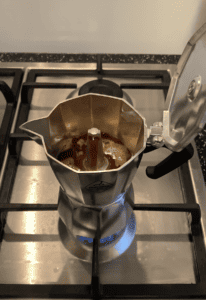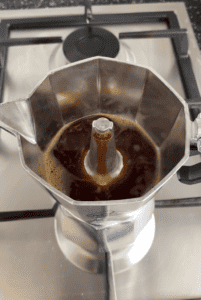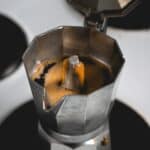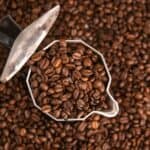How Much Pressure Does a Moka Pot Really Generate?
 Moka pots are traditional coffee making devices that brought pressurized extraction to the masses. But, how much pressure does a Moka pot actually generate, and how does this compare to some of its coffee making rivals?
For even coffee extraction, it is more desirable to hold Moka pot pressure between 0.75 and 1 bar (10 to 15 PSI), as this avoids over extraction and bitterness.
At the start of the brew, a Moka pot will generate around 0.5 bar (7.5 PSI) of pressure. However, as the water heats up and more steam is produced, pressure can rise to 1.5 bar (20 PSI).
Moka pots are traditional coffee making devices that brought pressurized extraction to the masses. But, how much pressure does a Moka pot actually generate, and how does this compare to some of its coffee making rivals?
For even coffee extraction, it is more desirable to hold Moka pot pressure between 0.75 and 1 bar (10 to 15 PSI), as this avoids over extraction and bitterness.
At the start of the brew, a Moka pot will generate around 0.5 bar (7.5 PSI) of pressure. However, as the water heats up and more steam is produced, pressure can rise to 1.5 bar (20 PSI).
What is a Moka Pot?
 A moka pot is a small coffee brewing device that sits on a stovetop and uses the heat to push pressurized, boiling water through ground coffee. This results in a strong, espresso-like coffee from this inexpensive device. Multiple chambers are used to separate the hot water at the bottom, the coffee basket in the middle, and the coffee collection chamber at the top.
In terms of how a Moka pot operates, it is more similar to an espresso machine or a percolator in the way it uses built up pressure and hot water to drive steam through finely ground coffee.
However, where an espresso machine uses gravity and a downwards flow of hot water to extract coffee from the beans, a Moka pot works in the opposite direction.
Water is added to the bottom chamber of the Moka pot, with fine to medium ground coffee placed in the filter basket which sits on top. Then, the coffee collection chamber is screwed on tightly and the whole thing is placed over a hot stovetop.
The stove heats the bottom of the Moka pot (made from aluminum) which then further boils the hot water above. This generates steam which, as the water boils over, rapidly evaporates through the coffee grounds and pushes hot coffee up through the central spout of the coffee collection chamber.
According to the Moka pot Wikipedia page, the device was first invented in 1933 by Italian designer Alfonso Bialetti, of Bialetti Industries. It then became a staple in Italian kitchens and soon spread throughout Europe.
European migrants (who had been displaced due to the second world war), brought their Moka pots to parts of South America and Australia, further spreading the usage of the device.
You may be wondering where the Moka pot gets its name…
Well, the Moka pot was named after the city of Mocha, in Yemen. Mocha has a rich history of being one of the original coffee trading ports and even drinks like the mocha are thought to also be named after the coastal city.
A moka pot is a small coffee brewing device that sits on a stovetop and uses the heat to push pressurized, boiling water through ground coffee. This results in a strong, espresso-like coffee from this inexpensive device. Multiple chambers are used to separate the hot water at the bottom, the coffee basket in the middle, and the coffee collection chamber at the top.
In terms of how a Moka pot operates, it is more similar to an espresso machine or a percolator in the way it uses built up pressure and hot water to drive steam through finely ground coffee.
However, where an espresso machine uses gravity and a downwards flow of hot water to extract coffee from the beans, a Moka pot works in the opposite direction.
Water is added to the bottom chamber of the Moka pot, with fine to medium ground coffee placed in the filter basket which sits on top. Then, the coffee collection chamber is screwed on tightly and the whole thing is placed over a hot stovetop.
The stove heats the bottom of the Moka pot (made from aluminum) which then further boils the hot water above. This generates steam which, as the water boils over, rapidly evaporates through the coffee grounds and pushes hot coffee up through the central spout of the coffee collection chamber.
According to the Moka pot Wikipedia page, the device was first invented in 1933 by Italian designer Alfonso Bialetti, of Bialetti Industries. It then became a staple in Italian kitchens and soon spread throughout Europe.
European migrants (who had been displaced due to the second world war), brought their Moka pots to parts of South America and Australia, further spreading the usage of the device.
You may be wondering where the Moka pot gets its name…
Well, the Moka pot was named after the city of Mocha, in Yemen. Mocha has a rich history of being one of the original coffee trading ports and even drinks like the mocha are thought to also be named after the coastal city.
How Does a Moka Pot Work?
Unlike most other coffee brewing methods that need hot water poured over the top or pressurized water flowing down through ground coffee, the Moka pot is a little different. What makes the Moka pot unique is the pressure rising up through the device due to heat being applied from below. This creates a little bit of pressure that forces the hot water and steam up through the coffee grounds, extracting liquid coffee and depositing it into the coffee collection chamber at the top of the Moka pot. Moka pots are operated using the following steps:- Unscrew the Moka pot and add hot water to the lower water chamber.
- Next, place the filter basket inside the water chamber (so it is sitting on top of the rim) and fill with medium to fine ground coffee.
- Using a tea towel, hold the base of the Moka pot and screw the upper half (coffee collection chamber) onto the water chamber.
- Then, place the fully assembled Moka pot onto a stovetop over a medium heat.
- Open the lid of the Moka pot so you can see the liquid coffee flow into the upper coffee collection chamber.
- When the device starts to sputter or the coffee collection chamber is nearly full, close the lid and remove from the heat.
How Much Pressure a Moka Pot Generates
 The amount of pressure generated by a Moka pot will vary depending on its size, the level of heat applied and the quantity and grind size of coffee used.
The more heat you apply, the larger the Moka pot and the finer you grind your coffee, the more pressure your Moka pot will generate.
However, more is not always better when it comes to pressure inside your humble Moka pot.
As David Maurice points out in his Youtube video below, holding the pressure constant is the key to a more even extraction and a better tasting cup of coffee.
David has added a pressure gauge to his more traditional Neapolitan style Moka pot, giving him more information whilst he is brewing. This allows him to hold his Moka pot pressure more constant, reducing the risk of over extraction towards the end of the brew.
As you can see, David’s Moka pot hovers between 10 and 15 PSI, which equates to approximately 0.75 to 1.05 bar of pressure.
This is less than the average quoted by most Moka pot manufacturers and coffee bloggers out there, and indicates that more pressure is not always the most desirable outcome when brewing coffee in a Moka pot.
The goal should be even extraction, not over extraction by producing as much pressure as possible.
Whilst pressure can be as low as 0.5 bar (7.5 PSI) as liquid coffee begins to flow, this can rise to around 1.5 or even 2 bar (22.5 to 30 PSI) if the heat applied to the bottom of the Moka pot is left unchecked.
This is very likely to produce frankly unpleasant coffee that is over extracted coffee that tastes burnt.
Therefore, I would recommend trying to keep the flow of coffee into your Moka pot’s coffee collection chamber as constant as possible, by constantly adjusting the heat applied to your Moka pot as David demonstrates.
As soon as coffee starts to flow, remove your Moka pot from the heat and then reapply heat intermittently by placing it back onto the stovetop as the flow of coffee starts to slow down.
The amount of pressure generated by a Moka pot will vary depending on its size, the level of heat applied and the quantity and grind size of coffee used.
The more heat you apply, the larger the Moka pot and the finer you grind your coffee, the more pressure your Moka pot will generate.
However, more is not always better when it comes to pressure inside your humble Moka pot.
As David Maurice points out in his Youtube video below, holding the pressure constant is the key to a more even extraction and a better tasting cup of coffee.
David has added a pressure gauge to his more traditional Neapolitan style Moka pot, giving him more information whilst he is brewing. This allows him to hold his Moka pot pressure more constant, reducing the risk of over extraction towards the end of the brew.
As you can see, David’s Moka pot hovers between 10 and 15 PSI, which equates to approximately 0.75 to 1.05 bar of pressure.
This is less than the average quoted by most Moka pot manufacturers and coffee bloggers out there, and indicates that more pressure is not always the most desirable outcome when brewing coffee in a Moka pot.
The goal should be even extraction, not over extraction by producing as much pressure as possible.
Whilst pressure can be as low as 0.5 bar (7.5 PSI) as liquid coffee begins to flow, this can rise to around 1.5 or even 2 bar (22.5 to 30 PSI) if the heat applied to the bottom of the Moka pot is left unchecked.
This is very likely to produce frankly unpleasant coffee that is over extracted coffee that tastes burnt.
Therefore, I would recommend trying to keep the flow of coffee into your Moka pot’s coffee collection chamber as constant as possible, by constantly adjusting the heat applied to your Moka pot as David demonstrates.
As soon as coffee starts to flow, remove your Moka pot from the heat and then reapply heat intermittently by placing it back onto the stovetop as the flow of coffee starts to slow down.
How to Change the Pressure Generated by a Moka Pot
As mentioned, dialing in the pressure of your Moka pot can be a tricky task. However, here are a few variables you can play around with to ensure you get the right level of extraction for your desired outcome.Apply More Heat
One way to alter the amount of pressure your Moka pot will generate is to apply more heat to the bottom of the device. Moka pots generate pressure as water approaches boiling point inside the water chamber, which sits at the bottom of the device. Therefore, applying more heat to your Moka pot will boil up the water more quickly, thereby generating more steam and more pressure.Decrease Grind Size
If you use a finer grind size, the surface area of your coffee puck will be larger and more compacted, making it more difficult for water to pass through each tiny granule. Whilst it is not advisable to tamp your Moka pot, using a finer grind size would be a good idea if you want to make the most of the pressure that the device generates. Using a smaller, finer grind size will also increase the pressure build up in the device, as it will be slightly more difficult for steam to pass through the bed of ground coffee sitting in the filter basket.Use a Larger Moka Pot
Whilst a larger Moka pot will take longer to heat up, once there is enough steam to rise up through the bed of coffee, more pressure will be generated overall. This is because there is a larger quantity of hot water forcing its way through a larger bed of ground coffee, and therefore more pressure is needed to extract those flavorful coffee oils from the finely ground beans. Again, it is important to mention that a more consistent pressure throughout the brew is probably more desirable than increasing the pressure rapidly towards the end of the brew. There are no prizes for over extracted, bitter tasting coffee!Moka Pot Pressure Compared to Other Brewing Methods
As discussed, a Moka pot tends to work best when the pressure is held relatively constant. This may be around 0.75 to 1 bar for a smaller 3 cup Moka pot, or around 1.5 to 1 bar for a larger 6 cup Moka pot. It really is a case of trial and error and you may end up with some bitter tasting cups on your journey to Moka pot mastery! However, here is how some of the Moka pot’s biggest coffee extraction rivals compare when it comes to generating pressure during a brew.Espresso Machine
The espresso machine is the most recognisable and popular way to produce strong shots of coffee using a highly strung, pressurized device. A typical espresso machine will operate at around 9 bar of pressure.Aeropress
Another, more recently developed method of extracting coffee using pressure is the Aeropress. The amount of force used to press down the plunger will of course influence the amount of pressure the device uses to force hot water through the coffee puck. Typically, this will sit between “0.35 to 0.75 bars of pressure”, according to Garrett Oden’s article on Java Presse, titled “Can the Aeropress Make Espresso”.Moka Pot Top Tips
Now the lid has been lifted on how much pressure a Moka pot really generates, here are a few top tips to help you get the best out of this rudimentary coffee maker. For a complete guide of how to use a Moka pot the right way, check out this article.Use Fresh Beans
Using fresh coffee beans will help you extract the best flavors and produce a clean tasting, delicious cup of coffee with your Moka pot. Avoid stale store bought beans and look instead for coffee beans that have a ‘roasted on’ date from your local coffee house.Don’t Tamp Your Moka Pot
One of the biggest misconceptions surrounding the Moka pot is whether or not it should be tamped. Just because the Moka pot extracts liquid coffee using pressure, this does not mean you should tamp the grounds! This could cause a coffee fuelled explosion and/or damage to your Moka pot. For a full breakdown of how this can happen by tamping your Moka pot, check out this article.Start on a Medium to Low Heat and Build it up
The best way to ensure an even extraction whilst using a Moka pot is to apply a relatively low level of heat to the base of the device to begin with, and gradually build it up. Pressure and heat will naturally rise throughout the brew, and you’ll experience a more aggressive flow of coffee as the coffee collection chamber starts to fill up. Therefore, it makes sense to adjust the intensity of the heat source throughout the brew by taking your Moka pot off the stovetop intermittently, especially if it starts to sputter and spurt too much!Clean Your Moka Pot Straight Away
Finally, once you’re done brewing your coffee, make sure to clean your Moka pot straight away. If coffee and oils are left in the pot, they will quickly turn rancid and impact the taste of your next brew in a bad way! If you want to avoid 17 of the most common Moka pot mistakes, click here.Summary
Overall, the amount of pressure generated by a Moka pot is relatively low compared to the more traditional espresso machine. However, there is still enough pressure to make delicious, strong coffee in a matter of minutes. The key to making great coffee with a Moka pot is to aim for an even extraction and a steady flow of coffee rather than an aggressive sputter.Moka Pot Pressure Frequently Asked Questions
No, not quite. Moka pot coffee is pretty strong, but it is nowhere near as intense as Espresso.
Moka pots can generate up to 1.5 bar of pressure, whereas espresso machines generate 9 bar of pressure.



